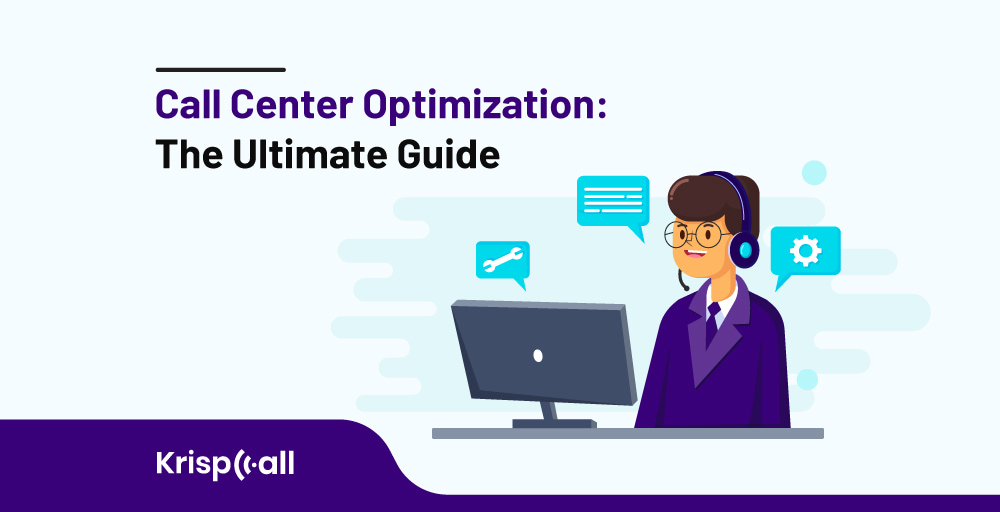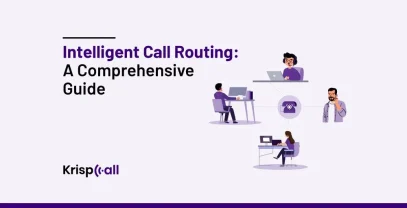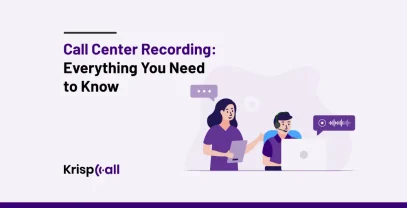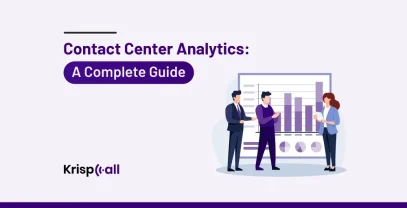Are you struggling to keep up with the demands of your call center? Are long wait times, frustrated customers, and overwhelmed agents becoming the norm? If so, you’re not alone. Many businesses face these challenges, but there is a solution.
Imagine a world where your call center is efficient and delightful. Customers are greeted with warmth and professionalism, their issues are resolved quickly and effectively, and agents are empowered to do their best work. This is the power of call center optimization.
This blog post will provide you with a step-by-step guide to call center optimization. We will cover everything from implementing call center software to training your agents. By the end of this post, you will have the tools you need to transform your call center into a hub of excellence.
🔑 KEY HIGHLIGHTS
- When looking for a call center optimization tool, it’s important to consider features such as IVR, skills-based call routing, call recording, and quality management.
- Call center optimization offers several benefits, including reduced costs, data-driven decision-making, and improved customer satisfaction.
- Call center optimization enhances the customer experience by reducing wait times, enabling faster problem-solving, and facilitating personalized interactions.
- Focusing on the agent’s experience, leveraging technology for efficiency, and optimizing workforce management are key best practices and strategies for enhancing call center performance.
What is Call Center Optimization?
Call center optimization is a strategic strategy that enhances the efficiency and effectiveness of call center operations. It involves utilizing various strategies and technologies to optimize operations, enable representatives, and guarantee prompt customer routing. Call center optimization combines strategies, digital channels, tools, and technologies for effectively managing the call center department, handling an extensive volume of calls to enhance the customer experience, and improving employee productivity.

The strategies include analyzing call data, implementing workforce management techniques, and other plans. By implementing call center optimization, businesses efficiently oversee their daily activities and improve employee productivity. Call center optimization offers advanced features like routing calls based on skills, dashboards displaying real-time performance, and workforce management tools.
Features to Look for in a Call Center Optimization Tool
Here are some features to look for in a call center optimization tool.
- Interactive Voice Response (IVR): The IVR system is an automated phone system that allows callers to access information via a voice response system of pre-recorded messages. This results in improved efficiency and reduced wait times.
- Skills-based call routing: This feature routes calls to the right agents with specific expertise and extensive experience to efficiently manage customer inquiries. It helps lead to a quicker solution and also increases customer satisfaction.
- Real-time dashboards & reporting: Real-time dashboards offer valuable insights into call access performance, including metrics like wait times, agents’ activity, and call volume. This empowers decision-making with the knowledge required to make informed decisions and helps with ongoing improvement efforts.
- Call recording and quality management: Call recording and quality management can help agents with coaching and quality monitoring. They can also help you identify the locations where the agents need improvement.
- Workforce management: This feature helps the agent to create schedules by considering call volume predictions and recorded data. This guarantees satisfactory staffing to meet customer needs efficiently and minimize hold periods.
- Omnichannel communication: In the modern era, call centers can be handled through various channels,, including phone, email, and chat. The tools employed in these centers must seamlessly merge these channels to ensure a consistent customer experience across all platforms.
- Artificial Intelligence (AI): Agents can focus on complex issues by employing AI-powered features like chatbots. It can effectively handle regular inquiries. Moreover, AI can analyze call recordings to identify customer opinions and suggest appropriate responses.
What are the Benefits of Call Center Optimization?
Improving call centers with better ideas can possibly be a Midas touch for a company. From increased efficiency in an organization to improved customer satisfaction, call center optimization offers a wide range of benefits to both the company and its customers.
Some of the benefits are as follows:
- Improved customer experience: Optimizing the call center’s workflow reduces customer wait time, increasing customer satisfaction and improving customer experience. With call center optimization’s advanced features, you can make connections more satiny and faster. This includes skills-based call routing, which ensures customers are connected with the most suitable agent to address their problems. All these factors contribute to enhancing the overall customer experience.
- Boost employee engagement: Proper workforce training and flexible working schedules prevent employee overwork and burnout, boosting their engagement. Empowering your agents with the right tools, resources, and training allows them to perform at their best. Moreover, optimized call centers provide clear performance metrics, coaching opportunities, and efficient workflows, increasing agent morale, engagement, and overall effectiveness.
- Increased productivity: Using advanced call center optimization tools and utilizing the available resources increases the overall team’s productivity. Analyzing data to forecast call volumes can enhance call center efficiency. By doing this, the call center can manage staff schedules. It also helps ensure adequate agents are available to handle calls during peak hours and control understaffing during off-peak hours.
- Cost savings: Optimizing the call center could potentially give a company the Midas touch. Whether it be reduced operational costs, lower turnover rates, or enlarged customer numbers, companies are almost guaranteed to save money. Call center optimization helps businesses save significant money by streamlining operations and improving agent performance. This leads to more calls handled with the same resources, lowering labor costs. In addition, reduced call abandonment rates, fewer transfers, and improved first-call resolution contribute to significant call center cost savings.
- Data-driven decision-making: Call center optimization can provide businesses with a treasure trove of data on call volume, agent performance, and customer satisfaction. This data lets you make informed decisions about staffing levels, training programs, technology investments, and overall call strategy.
- Increased first-call resolution (FCR): By utilizing call center optimization, you can tackle first-call resolution through better call routing that reaches customers with the right agents for their requirements. Moreover, providing agents with easy access to knowledge bases and resources supports them in effectively fixing problems during the initial call.
- Reduced abandonment rates: Call abandonment happens when a customer hangs up the call before the agent picks up, resulting in comprehensive wait times. You can effectively reduce abandonment rates by improving call routing and reducing wait periods through enhancing forecasting and staffing.
- Increased sales and revenue: To enhance customer satisfaction, one can promptly fix issues, increase customer satisfaction, and develop a favorable brand reputation. The service’s trustworthiness and effectiveness maintain customer trust and loyalty. Ultimately resulting in increased sales and revenue for your business.
How do you evaluate the performance of a call center?
Evaluating call center performance involves various key metrics and factors. Here are some of the widely used call center KPIs (key performance indicators) to evaluate their performance.
Average Handle Time (AHT)
AHT is the measure of time a CSR (Customer Service Representative) spends handling a customer interaction. Generally, companies associate less interaction time with more productivity. So, lower AHT is much more preferred than higher ones.
Mathematically, it is calculated by:
AHT = (Total Talk Time + Hold Time + After call work) / number of interactions
Customer Satisfaction Score (CSAT)
CSAT is a survey-based percentage metric used to measure how satisfied customers are with the company’s service. Typically, a survey is conducted, and questions like, “On a scale of 1-10, how satisfied are you with the products”, are asked. Based on that, they split out the number of satisfied and unsatisfied customers.
Simply, it is calculated by:
CSAT = number of Satisfied Customers/number of Respondents * 100
First Call Resolution (FCR)
First Call Resolution (FCR) is a metric that measures the ability of a call center to resolve a customer’s issue during their initial contact without the need to follow up with a second interaction.
Generally, FCR is measured in percentage and calculated by:
FCR = number of issues resolved in first interactions/total number of customer interactions * 100
Percentage of Calls Blocked
The percentage of calls blocked is also called the blocked call rate or, sometimes, the blockage rate. It is a performance indicator that measures the ratio of busy or blocked incoming calls that can’t be connected to an available agent.
High blockage rates can indicate several issues, like ineffective call handling, inefficient call routing, and other technical problems. The general method to calculate the blocked call rate is,
Percentage of Calls Blocked =number of blocked calls/number of incoming calls * 100
What are the Things to Optimize to Increase Call Center Performance?
Employee Performance
Boosting call center effectiveness relies heavily on improving employee performance. Therefore, team leaders should really focus on and invest in employee performance, whether it be providing training or monthly motivational rewards.

Skilled agents handle inquiries efficiently, resolve issues promptly, and leave customers with a positive experience, leading to shorter wait times and increased productivity. Thus, despite the high initial investment cost of optimizing employee performance, its long-term gains outweigh them.
Key Performance Metrics
While the metrics provide a good reference for the performance of a call center, they are not to merely watch out. Like a student who tends to study more to improve their grades, call centers should constantly work to excel in all the metrics.
These condensed forms of data can help identify issues in the work mechanism and provide solutions to address them. Apart from the above-mentioned metrics, some VoIPs can help you obtain other indexes, like call occupancy rates, cost per call, etc., that can be helpful in monitoring.
Workforce Management
Applying best practices and adapting various techniques to provide a standard/efficient workflow and, eventually, manage employees is called call center workforce management.
No matter the size of the workforce, a call center can become chaotic without proper management. Therefore, you should work on developing effective measures to cope with that. Sticking to flexible schedules and using proper communication channels can help a lot.
You should also ensure the implementation of proper procedures and principles, the integration of technologies like workforce management software, and the pursuit of high employee satisfaction and retention rates.
Service Quality
At its core, a call center’s principle is properly handling clients while addressing their queries. Therefore, the quality of service you provide depends upon the level of satisfaction they attain on call.
From communication to accurately delivering facts, an agent should have all the important call center skills, ensuring they are prepared for any scenario. Moreover, other factors may be responsible for your call center service quality.
Therefore, it is important to monitor, take feedback / constructive criticism, and constantly work to improve overall service quality.
6 Best Practices and Strategies to Optimize Call Center Performance
According to studies by Zippia, 40% of American customers are likely to give up on a company if they receive poor customer service. So, implementing the right techniques and strategies is a must to outweigh your competitors.
But what strategies do global business leaders use to ensure that their call center performance is smooth and efficient?
Here’s what they use. These are some industry-in-use professional call center optimization models that can help you reduce costs, improve customer service, and boost profits.
1. Always focus on agent training and development

From the tones of their voices to the accent of the language, from a standard script to handling random instances, every employee in your call center should be able to deal comprehensively with your client. You can do so by conducting training programs and teaching them to use appropriate customer management tools.
Even after completing the initial training phases, it is recommended that you provide routine training for your employees to boost their confidence. Constantly monitoring their work and providing them with constructive criticism will also help to improve their performance.
Also, try implementing reward systems to get the most out of your employees. Providing “Employee of the Month” awards and associating that with increased bonuses and paychecks will boost their morale to work harder and better. But ensure this doesn’t adversely impact productivity by creating a hostile environment.
2. Track Key Performance Indicators
Well, only a single key performance indicator among all the above-mentioned ones cannot solely evaluate the performance of your contact center. Therefore, it is essential for team leads to identify, use, and track the combination of the most relevant call center KPI examples to evaluate the performance accurately.
Establishing benchmarks and realistic targets based on your industry standards and regularly supervising them using real-time monitoring tools can make KPI tracking easier. Additionally, making reports of the tracked KPI data helps to identify trends, patterns, and areas for improvement.
3. Conduct A/B Testing
A/B testing in call center optimization, a.k.a. bucket testing or split testing, is a method for comparing two different versions of elements, whether written scripts, strategies, or the whole process. This helps identify changes that improve efficiency, customer satisfaction, and overall performance in the call center.
Here’s a brief cheat sheet guide to performing effective A/B testing to optimize your call center efficiency.
- Identify the objective: First, be sure about your final goal and which area you are targeting to improve. Then, choose the evaluation metrics accordingly.
- Choose variables to test: Once you identify your objective, select the variable that affects your goal. It might be the call script, call routing strategies, voice mail, or other variables.
- Randomize group assignment: Now, randomly assign the agents to either the control group (which will continue using the current process) or the treatment group (which will use the new process).
- Monitor the changes: After implementing the changes, monitor the KPIs and the performance of both elements.
- Analyze the tracked data: Now, analyze the changes’ performance and come up with a solid conclusion about which one to implement in production.
4. Implement Automation
Implementing automation in your call center is like upgrading your old traditional typewriter into a high-speed word processor. Just as a word processor accelerates the document creation process, automation in a call center speeds up customer interactions, reduces errors, and allows agents to concentrate on the nuances of customer service
Automating simple and repetitive tasks like data entry, updating customer records, and creating tickets reduces manual labor and the risk of errors. You can also automate call routing and use AI-powered chatbots to enhance customer satisfaction by providing quick and efficient routing and chat results.
5. Manage Customer Feedback
Ultimately, the goal of all this performance boosting and optimization is to satisfy the customer. Therefore, taking customer feedback and recommendations is the most important step to optimize your contact center performance.
Here are some quick tips on how you can ask customers for feedback for your call center optimization,
- Send out short email surveys to customers after a support interaction.
- While conducting a survey, include a mix of quantitative and qualitative questions.
- Handle social media and monitor for any mentions of your call center.
- Consider offering prizes and discounts as motivation for customers to provide feedback.
6. Optimize Workforce Management
It is important to have sufficient staff available during peak hours and who can prevent understaffing during slower times. Evaluate the caliber of call center assistance to pinpoint locations that need enhancement.
Call centers can utilize forecasting tools to anticipate call volume and schedule agents accordingly. This minimizes wait times and ensures suitable staffing during peak periods. Also, provide ongoing coaching and training to improve agent skills and knowledge to handle complex inquiries continuously.
Set to Optimize Your Call Center and Take it to the Next Level?
Let’s take your call center to the next level. Here are some advanced strategies to build on the best practices we discussed:
1. Omnichannel Support
The customer expects a smooth assistance experience across various phone, social media, and email channels. The objective is to deliver top-notch customer service via different communication channels, ensuring they receive consistent and excellent support.
2. Artificial Analytics
Discover the potential of AI-driven chatbots in addressing essential inquiries, and virtually reducing call traffic, allowing agents to concentrate on complex issues. AI can also deliver real-time understanding base requests to agents during calls enhancing FCR.
3. Speech Analytics
Utilize speech analytics software to pinpoint trends in customer opinion and common call topics. Utilize this data for informed decision-making and continuous optimization. By combining speech analytics with conversational AI and workforce optimization tools, a strong ecosystem is formed, enabling complete optimization of call center operations.
4. Customer Journey Mapping
By effectively utilizing customer journey mapping, you can increase your call center’s performance to a higher level. You can also Identify pain points, bottlenecks, and locations where customers face challenges.
Tracing the different touchpoints along the customer journey is essential to guaranteeing that each interaction is optimized for maximum impact.
5. Workforce Management Optimization
Global workforce management tools can help you predict call volume and schedule agents accordingly. They also have advanced features like speech and text analysis, automated recognition, and question analysis that can improve your call center’s efficiency.
This indicated that you have the right agents to handle incoming calls efficiently, decreasing hold time and improving agent confidence.
What are the Key Technologies in Call Center Optimization?
Technology plays a crucial role in optimizing the efficiency of a call center, as its impact extends across various aspects.

By leveraging the right mix of technologies, call centers can stay competitive, adapt to changing customer expectations, and continuously enhance their performance.
Have a vivid look at some of the revolutionary key technologies for call center optimization.
- Workforce Management Software: Call center workforce management software provides forecasting and scheduling tools to optimize overall agent staffing. This improves resource utilization, reduces overstaffing or understaffing, and enhances overall efficiency.
- Omni-channel Integration: Integrations allow you to combine other technological tools to use a unified platform. This provides a consistent customer experience across social media, email, and voice messages, enabling agents to handle interactions through their preferred channels.
- Chatbots and Virtual Assistants: AI-enabled chatbots and virtual assistants are quite handy and efficient when it comes to handling simple and repetitive tasks. Tasks like assisting customers with routine inquiries and providing simple information can be automated, freeing up human agents for more complex and value-added interactions.
- Cloud-based Technologies: Installing expensive hardware and software makes it difficult for businesses to manage their budgets and resources, hampering their call center performance. However, a cloud-based solution solves the problem in one go, making it more scalable, cost-effective, and easily manageable.
- Predictive Analysis: Analyzing predictive data using various techniques can help businesses predict call volume, predict customer churn, and even identify potential customers. This information can be used to make proactive decisions that can improve call center performance.
Top 3 Call Center Optimization Software in 2024
One of the best ways to enjoy all the essential and key technologies in a single pack is to use call center optimization software. They are feature-rich and make the optimization much more convenient and streamlined.
However, numerous software claim to be the best of all, making it much more difficult to research and choose the one that fits your business. So, to make your research process easy, here’s a list of the top 3 call center optimization software on the market right now.
1. KrispCall
KrispCall is a cloud-based contact center optimization system with all the necessary tools and features to optimize call operations. In fact, it’s not just a call center optimization tool; it’s a complete package and a one-stop solution for your VoIP-based cloud telephony needs.
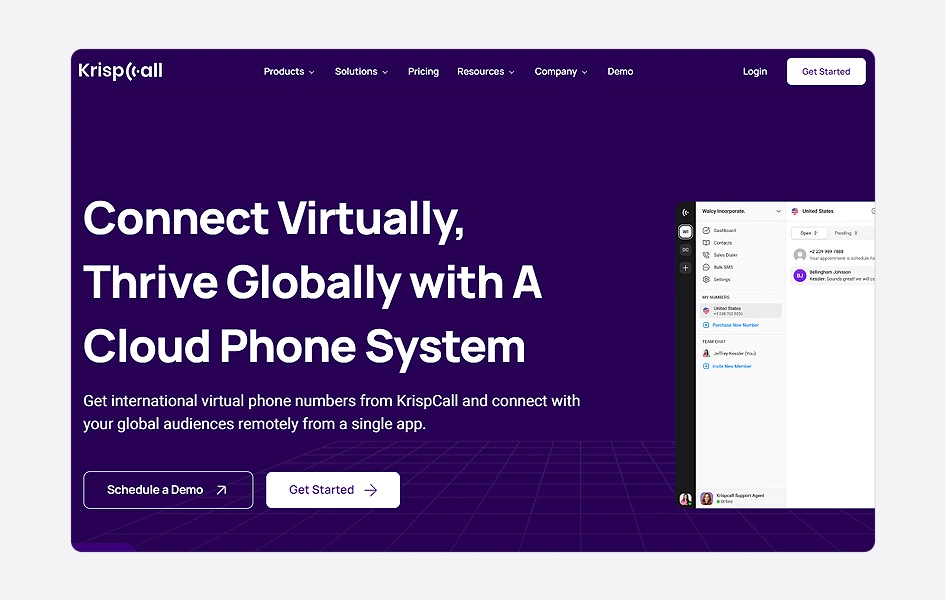
Used and trusted by over 4,500 companies, KripsCall offers its services in over 100 countries, including the USA and Canada. It is suited for both large-scale and small enterprises because of its numerous diverse features at a very inexpensive and reasonable price.
KrispCall’s Key Features:
Along with the basic features like call routing, forwarding, and voicemail, KrispCall offers some unique features, unlike other call center optimization software. This includes:
- Unified Callbox
- Smart IVR (Interactive Voice Response)
- Shared Number
- CRM and helpdesk Integrations like HubSpot and Pipedrive
- In-app call analytics
- Simultaneous call handling
- Call Monitoring
Pricing:
- Essential: $12/user/month
- Standard: $32/user/month
- Enterprise: Customizable
2. Ameyo
Founded in 2003, Ameyo is one of the oldest call center workforce management software. It was established with the motto of creating astonishing memories of the customer experience at every touchpoint and has been continuing that legacy ever since.
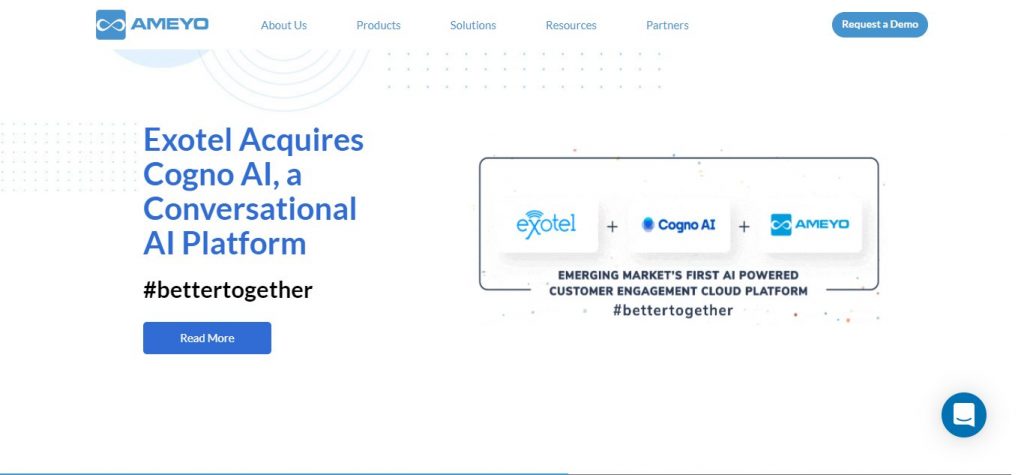
Offering its services in 60+ countries, Ameyo has won over 40 awards and recognition for providing a robust contact center solution.
Ameyo’s Key Features:
- Auto Dialer
- Predictive Dialer
- Interactive Dashboards
- CRM integrations
- HelpDesk Automation
Price:
Pricing is customizable, so request Ameyo’s sales team to learn the exact cost details.
3. CloudTalk
CloudTalk is VoIP-based contact center solution software mostly used by sales and customer service teams. Its built-in analytics allow managers to optimize performance and increase call efficiency by automating workflows.
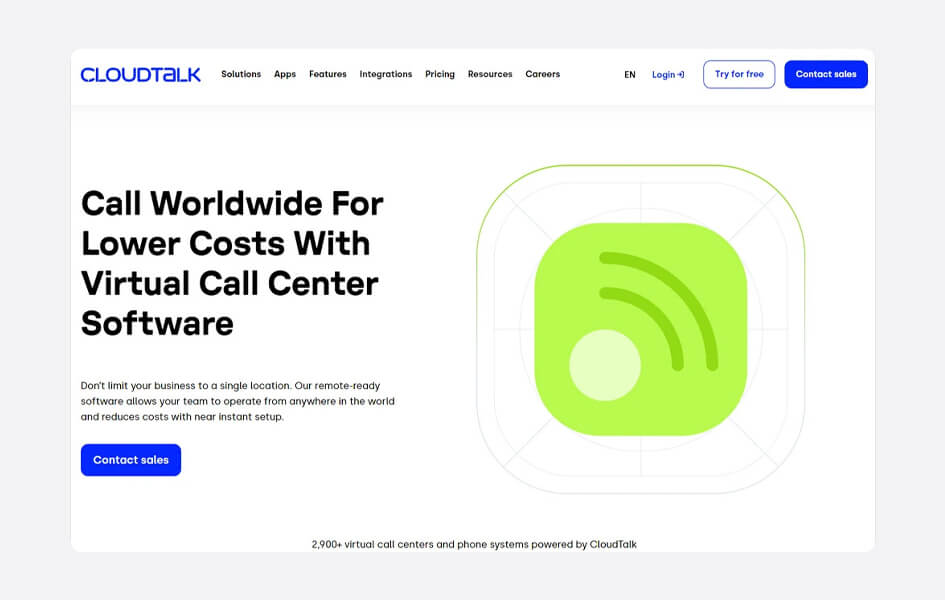
The main reason behind including CloudTalk in this list is its wide range of features (more than 70), including AI-powered conversational intelligence. This gives you the flexibility to customize the customer experience according to your needs.
Key Features:
- Call recording
- Call forwarding
- Automatic call transcription
- Call analytics
- CRM integrations
Pricing
- Starter: $25/user/month (billed annually)
- Essential: $30/user/month (billed annually)
- Expert: $50/user/month (billed annually)
- Custom: Request a custom quote
Conclusion
In summary, mastering call center optimization is the key to unlocking the benefits of call center business communication. From improving the customer experience to boosting employee engagement and achieving cost savings, the impact is profound.
Understanding the challenges inherent in call centers and the need for optimization can help you prepare the most efficient strategies. Many have been discussed earlier in this article, and you will have to figure out others considering what works best for your call center.
Bear in mind that the integration of technology and the use of proper tools/software are crucial to enhancing the call center’s performance. Therefore, you should be wise enough while selecting one.
FAQs
What is call center workforce optimization?
Call Center workforce optimization is a comprehensive way to implement various tactics within the members to improve the combined productivity of a team. It involves technologies and methodologies to ensure that the workforce delivers exceptional customer service.
The tactics include workflow automation, performance analysis, quality monitoring, technology integration, feedback surveys, etc.
What are the features to look for in call center optimization software?
Some of the must-look features in call center optimization software are:
- Real-time Monitoring.
- Performance reporting tools.
- Easy adaptability and scalable interface
- Integrations
- IVR (Interactive Voice Response)
How to improve call center operations?
To improve call center operations, you can use various call center optimization models and tactics. Some of the best industry-in-use techniques and strategies are as follows:
- Set up a clear goal for your business and call center.
- Identify the best-suit combination of KPIs to evaluate the performance.
- Provide scheduled employee training.
- Make use of technologies like workforce management tools and cloud-based call center software.
- Promote a positive and supportive work environment.
How can technology be leveraged in call center strategies?
Technology can be leveraged in call center strategies in numerous ways. Integrating technologies in call centers enables streamlined processes, enhances customer interactions, and reduces the overall cost of the system.
Call centers can provide personalized service, anticipate customer needs, and proactively address issues by leveraging in-demand high-techs like AI-powered chatbots, predictive analytics, and cloud-based solutions. Integrating CRM platforms and self-service options further transforms call centers into proactive and customer-centric hubs, boosting operational efficiency and driving business growth.

